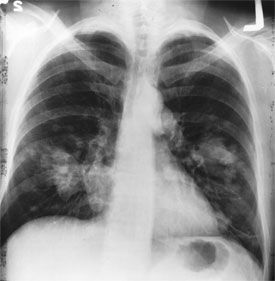Effective Options Arise for Patients With ALK-Positive NSCLC
New treatments that are currently in development have begun to show promise for patients diagnosed with ALK-positive non-small-cell lung cancer (ALK+ NSCLC), a subset of patients who have historically faced poor outcomes.
Source: The Web site of the National Cancer Institute (http://www.cancer.gov).

This is an x-ray image of a chest. Both sides of the lungs are visible with a growth on the left side of the lung, which could possibly be lung cancer.
Source: The Web site of the National Cancer Institute (http://www.cancer.gov).
New treatments that are currently in development have begun to show promise for patients diagnosed with ALK-positive non-small-cell lung cancer (ALK+ NSCLC), a subset of patients who have historically faced poor outcomes.
In 2013, the Food and Drug Administration gave LDK378, an agent produced by Novartis, a Breakthrough Therapy designation, after researcher Alice T. Shaw MD, PhD, of Massachusetts General Hospital Cancer Center in Boston, presented results of a phase I single-arm study at the 49th Annual Meeting of the American Society of Clinical Oncology (ASCO) in Chicago in June of that year. The FDA’s Breakthrough Therapy designation is intended to help accelerate the review and development of this potential new treatment.
According to the phase I study by Shaw et al, patients with ADK+ metastatic NSCLC with disease progression, who were previously untreated or treated with crizotinib, were treated with 750 mg/day of LDK378 (n=78). Another 36 patients were treated with 400 to 750 mg/day of LDK378. The median time that patients received treatment was 8.2 months.
A Better Outlook
Shaw et al found an overall response rate (including a complete response and partial response) of 60% in patients receiving 750 mg/day. “These results confirm that LDK378 has activity in patients with ALK+ NSCLC, including those who have progressed on crizotinib, as well as those who haven’t taken crizotinib,” said Shaw in a Novartis press release. “LDK378 may become another standard targeted therapy for these ALK-positive patients.”“With the recent discovery of ALK inhibitors such as crizotinib and LDK378, the prospects for ALK+ NSCLC patients is significantly better than a few years ago,” said Wen Wee Ma, MBBS, an associate professor of Oncology in the Department of Medicine at Roswell Park Cancer Institute in Buffalo, New York.
“There have been rapid and exciting advancements in drug development, specifically for this population, in the past few years,” said Ranee Mehra, MD, assistant professor of Medical Oncology at Fox Chase Cancer Center in Philadelphia, Pennsylvania. “An example of this is obviously crizotinib. In addition, the development of second-generation ALK inhibitors, which exhibit good clinical activity, has been equally promising and provides further hope. We still need to learn more about mechanisms of resistance, but the availability of active agents is already allowing us to offer patients treatments now.”
For such patients, those treatments may be life prolonging. People with this diagnosis are typically identified under age 50, and have either never smoked or are former smokers, said Ma and Mehra. However, “This disease certainly can occur in patients older than 50 and also in those who had a smoking history,” Mehra noted. “In practice, we try to test all patients with adenocarcinoma of the lung for this translocation event, regardless of age or smoking history.”
Early-stage disease doesn’t typically show symptoms; advanced stages can include a new cough that doesn’t dissipate, changes in a chronic cough, coughing up blood, shortness of breath, chest pain, fatigue or weakness, wheezing, hoarseness, unexplained weight loss, or recurrent pneumonia or bronchitis.
Importance of Early Identification
“When [patients] start on effective therapy, they remarkably have good disease control and can live active lives, in which they continue to work and care for their families,” said Mehra. “Unfortunately, resistance to treatment does develop, and as a group they [patients] have been very aware of new agents and clinical trials, and have been motivated with regards to traveling for care and enrolling in studies.”The ALK+ designation, which is a genetic alteration known as a translocation, occurs in about 3% to 5% of all lung cancers, or about 50,000 people around the world, according to a report Shaw gave in 2012 at the European Society for Medical Oncology (ESMO) Congress. “ALK becomes oncogenic when chromosomal translocation occurs betweenALKand other genes such as EML4,” said Ma. “The resultant fusion proteins can be selectively targeted by drugs such as LDK378 and crizotinib, and with a relatively well-tolerated side effect profile compared to cytotoxics.” The reported side effects of LDK378 include nausea, diarrhea, vomiting, and fatigue.
The earlier the ALK positivity of NSCLC can be identified, through fluorescence in situ hybridization (FISH), according to Ma, the earlier the patients have access to life-prolonging treatment with ALK inhibitors. “When detected early, the patient can be offered drugs targeting the abnormalALKfusion protein, which generally have a better side-effect profile than the traditional cytotoxic chemotherapy,” said Ma.
Mehra stressed the importance of early identification of disease “As with other lung cancers, the ability to cure is only an option for early-stage disease,” said Mehra. “Unfortunately, many patients are diagnosed with advanced, metastatic disease, and while treatment with ALK inhibitors can be very effective even for metastatic disease, the goal at that time is to palliate and control the disease.”
Bispecific Antibodies and ADCs Deliver a Futuristic Horizon Across Lung Cancer Settings
October 23rd 2024Recent advancements in protein engineering, especially antibody-drug conjugates, show promise in lung cancer treatment, with ivonescimab outperforming pembrolizumab in PD-L1-positive advanced non-small cell lung cancer.
Read More